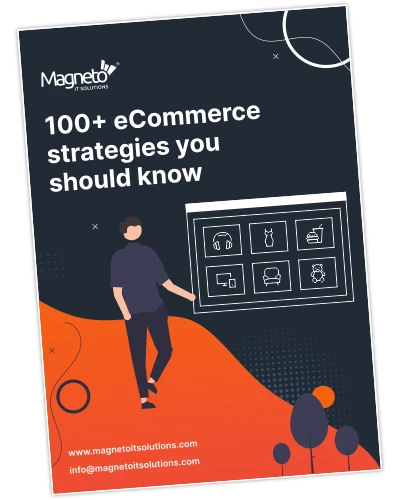In today’s competitive online grocery market, it is critical to employ effective marketing strategies to expand your customer base and boost sales. According to eMarketer, online grocery sales in the United States are projected to reach a billion by 2025, accounting for 20% of total grocery retail sales.
This change in online grocery industry is changing the new customer expectations has majolry change the grocery business. It has also introduced the need for new trends to offer businesses the opportunity to improve customer loyalty and increase sales and profit in the digital age.
In this blog, we’ll discuss the best marketing strategies for building a loyal customer base and making your online grocery business.
Trends In Online Grocery Business For New-Age Customers
Implementation of Personalization
Personalization is essential for remaining competitive in the online grocery industry. Shoppers have similar preferences, so provide tailored experiences. AI and machine learning analyze interactions to provide personalized recommendations, resulting in 40% more revenue.
With more customer data available, AI can enhance the shopping experience. For example, Instacart employs machine learning to make data-driven decisions that increase customer satisfaction.
Use of Omnichannel Option
The grocery industry is changing as more people shop both online and in-store. Businesses must use data to meet customer expectations and deliver a consistent experience across all channels.
A reent study found that omnichannel shoppers account for 86% of consumer packaged goods (CPG) dollar sales in the United States, emphasising the growing importance of providing both online and in-store options.
Customers favor a mix of online and in-store shopping. Grocery stores can improve the shopping experience by integrating digital tools and providing a seamless journey for customers.
Social Commerce Implementation
Grocery stores are increasingly using social media to sell their products. They create content that you can click on to purchase what they’re offering. This makes it easier to shop for groceries while using social media.
Grocery brands are using social media to showcase recipes for which you can purchase ingredients, as well as to conduct live videos and share short videos. When you find something you like, you can purchase it right away. This helps grocery brands get noticed and encourages you to buy their products when you shop online.
Sustainability Initiatives
Consumers are prioritizing sustainability and looking for environmentally friendly grocery products. There is a growing demand for plant-based foods, and customers expect brands to be environmentally responsible.
According to a recent Bazaarvoice survey, 60% of global shoppers prioritize sustainable and eco-friendly products in their purchasing decisions. Grocery brands can connect with environmentally conscious customers by focusing on green initiatives.
Use of Voice Search
Voice technology is transforming the way people buy groceries, making it easier and faster. According to recent studies, 55% of households will own a smart speaker by 2025, demonstrating the increasing use of voice assistants in everyday life.
Customers can add items to their shopping lists hands-free by asking questions such as “What fruits are on sale?” or “Reorder my almond milk.” As voice technology advances, it will provide more personalized experiences, such as recipe recommendations based on dietary preferences. Grocery retailers must embrace this innovation in order to retain customers and remain competitive.

Mobile Shopping And App Usage
With the development of digital commerce, more people are now purchasing groceries through mobile apps. Large retailers such as Walmart and Target have their own grocery apps. Walmart stated that its grocery app helped increase online sales by 24% last year.
Also, platforms such as Instacart and UberEats allow grocery stores to sell online even if they do not have their own app. Wave Grocery and other similar services enable smaller businesses to enter the digital marketplace without incurring significant software costs. People are at ease using store apps and third-party services to buy groceries on their phones.
Top Marketing Strategies for Your Online Grocery Business
Understanding Your Audience
To differentiate your grocery store, focus on specific customer groups and understand their preferences using customer data and analysis. According to a Forbes study, 90% of consumers are willing to shop and pay more for personalized experiences.
Whole Foods uses customer data to improve marketing and has experienced an increase in sales in specific product categories. Understanding the lifestyle, demographics, and interests of your target audience can assist you in identifying priority customer segments.
According to research, 73% of millennials are willing to pay a higher price for environmentally friendly products, which helps the grocery owners to cater to this demographic by emphasizing organic and sustainable options.
Boosting Online Presence
The grocery industry has shifted rapidly online, with approximately 1.4 billion people ordering groceries digitally. Therefore, grocery e-commerce owners must work on developing user-friendly websites and using effective search engine optimization (SEO) strategies to make their stores visible to the right customers.
According to research, 75% of users assess a company’s credibility based on its website design. As demonstrated by Walmart’s increase in online grocery sales during the pandemic, local SEO strategies can significantly impact grocery store success.
Hence, grocery stores can improve their sales and visibility by developing well-designed websites and local SEO.

Leveraging Social Media Marketing
Social media is essential for your online grocery store. It will help you connect with your customers when they scroll up their feeds. The most useful social media platforms for online grocery shopping are Facebook, Instagram, Pinterest, YouTube, and LinkedIn.
On these popular social media platforms, grocery owners can target customers by creating engaging content that connects the user with the brand. These platforms are very effective for running polls and collaborating with influencers to reach a larger audience.
However, It is critical to select the appropriate platforms and tailor your content to each platform’s culture. Hence, experimenting with various strategies to determine what works best for your store is necessary.
Community Engagement And Local Partnerships
Online grocery stores, like traditional stores, can thrive by cultivating strong relationships with their local communities. Community involvement increases brand visibility and creates opportunities for joint promotions.
According to a recent study, 66% of consumers are willing to pay more for brands that prioritize social and environmental impact, highlighting the importance of local connections.
Collaborating with local farms for fresh products attracts customers who value sustainability, as demonstrated by Farmigo. Furthermore, hosting local events can build trust and loyalty, with 87% of consumers preferring brands that support causes they care about. Engaging with the community ultimately improves reputation and increases sales.
Invest In Your Website
It’s critical to invest in your grocery store’s website because more and more people are shopping online. About 1.4 billion people use digital grocery services. Customers frequently visit your website first to place an order or locate your store.
Include important information such as your location, hours of operation, and available departments. People expect web pages to load in less than two seconds, so having an easy-to-use website is beneficial.
For example, Kroger offers weekly discounts to attract customers. Furthermore, promoting third-party delivery services such as Instacart can make things easier for customers while also allowing more people to discover and return to your store.
Checkout Process For Conversion
When adding online ordering to your grocery website, a simple checkout process is essential. Customers can create accounts with e-commerce software to make transactions easier and save credit card information for later use.
Streamlining the checkout experience not only improves convenience but can also significantly increase sales; according to studies, 28% of customers abandon their carts due to a complicated checkout process.
This helps the grocery retailer to design their websites in such a manner that they can also recommend items based on previous purchases, making reordering more convenient and increasing average order value.
Data-Driven Decision-Making
In today’s tech-driven grocery retail environment, tools like Google Analytics and delivery management software are critical for tracking critical data like customer satisfaction and order values.
According to a McKinsey study, businesses that use data analytics to inform decisions can increase productivity by 20% to 25%.
Walmart forecasts demand using sophisticated analytics and adjusts inventory levels accordingly to boost stock management choices and customer satisfaction.
Launch A Loyalty Program
According to recent research, 79% of consumers say loyalty programs increase their likelihood of continuing to do business with a brand. However, ensuring customer loyalty is a critical job for the grocery retailer; therefore, having an effective strategy is important.
Using a reward program for the customer is a great form of loyalty campaign. This process can be done by rewarding them for their frequent purchase. These rewards can be provided in the form of free items, personalized discounts, promotions, and lots more.
This strategy will be helpful for encourage repeat purchase, and cultivate loyal customer base for long-run. This process can be also done by using email campaign and social media marketing to target the right customer better and share these loyalty program often through push notificatiosns, social ads, and personalized emails for better response.
Use Email Marketing
Email marketing is an effective tool for online grocery businesses. As of 2023, 92% of internet users communicate via email. Customers who sign up for your email list are interested in staying connected with your brand.
Grocery stores rely on repeat business because customers frequently need to replenish household supplies. Email marketing can ensure that your store is the first place they think of when they need to restock.
Sending engaging content, relevant promotions, and consistent reminders via email can significantly increase the likelihood of repeat visits. You can use email marketing strategically to build long-term relationships with your customers and drive sustained growth for your online grocery business.
Use of Offers and Promotions
Offering discounts and coupons is an effective strategy for influencing customer decisions at online grocery stores. According to a Nielsen survey, 60% of shoppers said they are more likely to buy a product with a coupon.
Digital coupons, exclusive email promotions, and website displays are some of the ways that online grocery stores can deliver these offers.
For example, Target’s Circle Rewards program effectively combines in-store promotions and personalized offers based on customer behavior, increasing sales among loyal members. Discounts and targeted promotions can help online grocery businesses increase customer loyalty and drive repeat purchases.
Final Word
The grocery market has constantly changed for the past few years. These changes are majorly shifting consumer behavior, business mode, and consumption. This changing behavior and pattern is expected to continue more in the future. As a result, staying up to date on current trends is critical for keeping your company competitive.
Following the right strategy to cater to the latest trends is the key to success; thus, considering and implementing these marketing strategies can help you take your grocery business to the next level. However, grocery stores frequently struggled with selecting the appropriate techniques.
Working with a grocery eCommerce expert can help overcome these challenges and run a successful online grocery store that promotes customer retention and better sales growth.


















